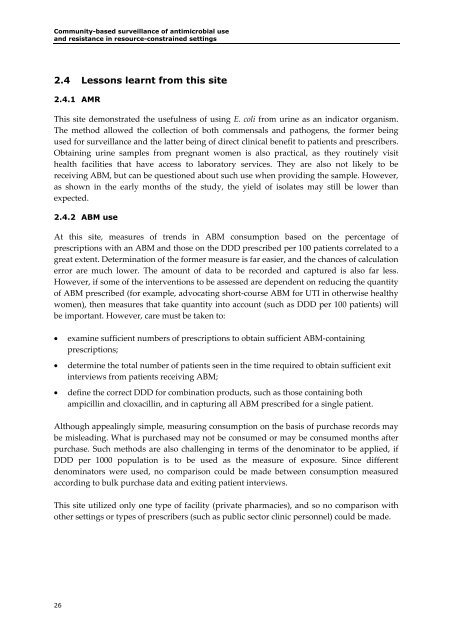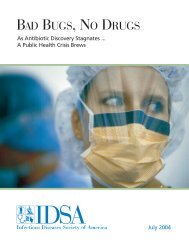Community-Based Surveillance of Antimicrobial Use and ...
Community-Based Surveillance of Antimicrobial Use and ...
Community-Based Surveillance of Antimicrobial Use and ...
- No tags were found...
Create successful ePaper yourself
Turn your PDF publications into a flip-book with our unique Google optimized e-Paper software.
<strong>Community</strong>-based surveillance <strong>of</strong> antimicrobial use<strong>and</strong> resistance in resource-constrained settings2.4 Lessons learnt from this site2.4.1 AMRThis site demonstrated the usefulness <strong>of</strong> using E. coli from urine as an indicator organism.The method allowed the collection <strong>of</strong> both commensals <strong>and</strong> pathogens, the former beingused for surveillance <strong>and</strong> the latter being <strong>of</strong> direct clinical benefit to patients <strong>and</strong> prescribers.Obtaining urine samples from pregnant women is also practical, as they routinely visithealth facilities that have access to laboratory services. They are also not likely to bereceiving ABM, but can be questioned about such use when providing the sample. However,as shown in the early months <strong>of</strong> the study, the yield <strong>of</strong> isolates may still be lower thanexpected.2.4.2 ABM useAt this site, measures <strong>of</strong> trends in ABM consumption based on the percentage <strong>of</strong>prescriptions with an ABM <strong>and</strong> those on the DDD prescribed per 100 patients correlated to agreat extent. Determination <strong>of</strong> the former measure is far easier, <strong>and</strong> the chances <strong>of</strong> calculationerror are much lower. The amount <strong>of</strong> data to be recorded <strong>and</strong> captured is also far less.However, if some <strong>of</strong> the interventions to be assessed are dependent on reducing the quantity<strong>of</strong> ABM prescribed (for example, advocating short‐course ABM for UTI in otherwise healthywomen), then measures that take quantity into account (such as DDD per 100 patients) willbe important. However, care must be taken to:• examine sufficient numbers <strong>of</strong> prescriptions to obtain sufficient ABM‐containingprescriptions;• determine the total number <strong>of</strong> patients seen in the time required to obtain sufficient exitinterviews from patients receiving ABM;• define the correct DDD for combination products, such as those containing bothampicillin <strong>and</strong> cloxacillin, <strong>and</strong> in capturing all ABM prescribed for a single patient.Although appealingly simple, measuring consumption on the basis <strong>of</strong> purchase records maybe misleading. What is purchased may not be consumed or may be consumed months afterpurchase. Such methods are also challenging in terms <strong>of</strong> the denominator to be applied, ifDDD per 1000 population is to be used as the measure <strong>of</strong> exposure. Since differentdenominators were used, no comparison could be made between consumption measuredaccording to bulk purchase data <strong>and</strong> exiting patient interviews.This site utilized only one type <strong>of</strong> facility (private pharmacies), <strong>and</strong> so no comparison withother settings or types <strong>of</strong> prescribers (such as public sector clinic personnel) could be made.26




